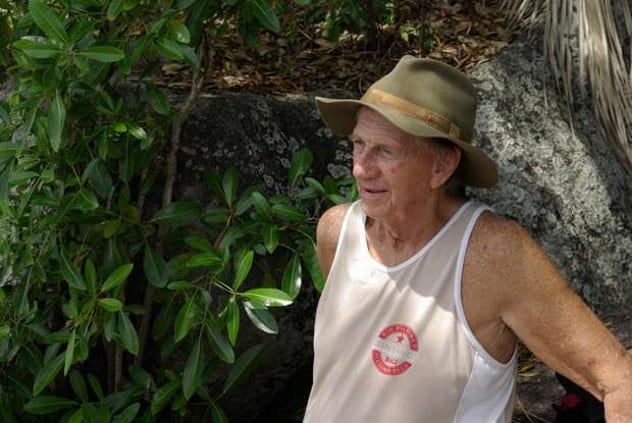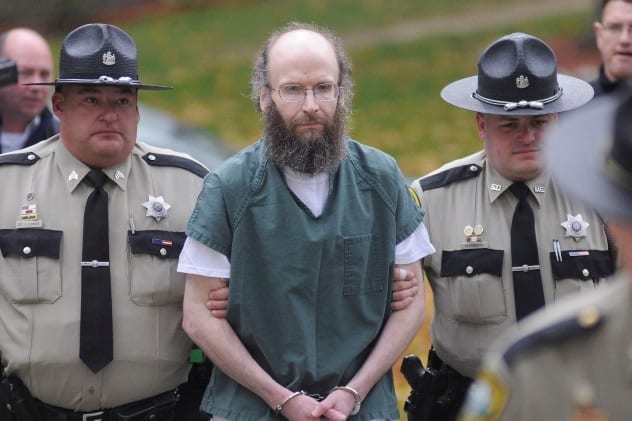 Animals
Animals  Animals
Animals  Gaming
Gaming 10 Game Characters Everyone Hated Playing
 Books
Books 10 Famous Writers Who Were Hypocritical
 Humans
Humans 10 of the World’s Toughest Puzzles Solved in Record Time
 Mysteries
Mysteries 10 Scientific Mysteries We Don’t Fully Understand
 Weird Stuff
Weird Stuff 10 Celebrities Who Have Admitted to Alien Encounters
 Our World
Our World 10 Surprising Secrets of Notre Dame Cathedral
 Miscellaneous
Miscellaneous 10 Intriguing Origins of Popular Carnival Rides
 Weird Stuff
Weird Stuff Ten Unexpected Discoveries Involving Vomit
 Movies and TV
Movies and TV 10 Actors Who Almost Didn’t Take Career-Defining Roles
 Animals
Animals 10 Amazing Animal Tales from the Ancient World
 Gaming
Gaming 10 Game Characters Everyone Hated Playing
 Books
Books 10 Famous Writers Who Were Hypocritical
Who's Behind Listverse?

Jamie Frater
Head Editor
Jamie founded Listverse due to an insatiable desire to share fascinating, obscure, and bizarre facts. He has been a guest speaker on numerous national radio and television stations and is a five time published author.
More About Us Humans
Humans 10 of the World’s Toughest Puzzles Solved in Record Time
 Mysteries
Mysteries 10 Scientific Mysteries We Don’t Fully Understand
 Weird Stuff
Weird Stuff 10 Celebrities Who Have Admitted to Alien Encounters
 Our World
Our World 10 Surprising Secrets of Notre Dame Cathedral
 Miscellaneous
Miscellaneous 10 Intriguing Origins of Popular Carnival Rides
 Weird Stuff
Weird Stuff Ten Unexpected Discoveries Involving Vomit
 Movies and TV
Movies and TV 10 Actors Who Almost Didn’t Take Career-Defining Roles
10 Strange Hermits You (Obviously) Don’t Know About
Traditionally, hermits have been people who have withdrawn from the world in order to spend time in prayer and meditation. Most religions recognize living as a hermit as a form of devotion. However, there are, and it seems there always have been, other sorts of hermits—those who withdraw from the world not to get closer to God but to get away from other human beings.
For some, their life of solitude was born out of tragedy. For others, it seems to have been simply a lifestyle choice. Here, we examine ten nonreligious hermits and their extraordinary lives.
10 The Leopard Man Of Skye

Tom Leppard was certainly an extraordinary-looking man. His entire body was covered in tattooed leopard spots. At one time, he held the world record for tattoos. Leppard had spent 30 years in military service, and on his discharge, he found it difficult to mix with other people. He decided to get himself tattooed in order to stand out from others, which he certainly did. He never claimed any particular affinity to leopards but felt that if he looked unique, people might pay to photograph him. He also chose leopard spots, apparently, because they were easy for the tattooist to do.
He lived for 20 years on the remote Scottish Isle of Skye. He built himself a “cave” from the ruins of a bothy that sat on the edge of Loch na Beiste. There were no windows, gas, or electricity when he arrived, and he never put any in. He didn’t attempt to make the cave a home, leaving the thatched roof to rot. The makeshift metal roof he put over it was so low that he could not stand up straight in his own home.
He cooked on a camping stove and slept on a bit of old board through the hot summers and freezing winters but seemed to enjoy his life. Though he did not mix much with the local population, he was well-liked, and they respected his independence.
The only trouble came after a German woman, who claimed she was a vampire, was tried for killing a man in a Satanic ritual. She had stayed with Leppard on a holiday a few years earlier and claimed that he had taught her how to worship the Devil. Leppard, however, denied the suggestion and said she was merely a teenager who had come for a visit.
Leppard moved to a care home in 2008 after becoming too old for his weekly kayak trip to do his shopping, and he remained there until his death in 2016.[1]
9 The Hermit Of Griffith

Valerio Ricetti emigrated to Australia from Italy when he was a teenager, just as World War I was drawing to a close. He worked first as an itinerant manual laborer and then as a gardener. After arriving in the town of Griffith, he began work on his Garden of Eden.
He was said to have been suffering from a broken heart when he began his work. He wanted somewhere that he could be alone. The caves within his garden became his retreat. He spent 23 years building terraces and walkways and growing his own food. He built a shrine, presumably to his lost love, and carved inscriptions in the rocks.
He called his garden mia sacra collina (“my sacred hill”). What is left of the site is now a haven for visitors, who come to admire not just the Hermit’s Cave but also the shelters, terraced gardens, dry stone walls, bridges, staircases, and paths that crisscross the site. His garden was clearly a labor of love and would have required the removal of tons of earth. Ricetti worked at night in order to remain unseen by the locals.
When World War II broke out, the Australian government, convinced that he was a spy, interned him in a prisoner of war camp. After the war, he was returned to Italy, where he died, never seeing his beloved garden again.[2]
8 The Hermit Of Redcoats

James Lucas was born in 1813. He was wealthy and, it has to be said, always a little odd. Indeed, he was often known by his nickname “Mad Lucas.” After his mother’s death in 1849, he barricaded himself inside his mansion near Redcoats Green, Hertfordshire, and remained inside for the next 25 years, taking regular deliveries of groceries, which mostly consisted of milk, bread, and gin.
However, far from hiding from the world, Lucas, from behind his barricaded front door, enjoyed being a curiosity. Thousands of visitors made the journey to Redcoats Green to see him. Lucas wore only an old blanket but accessorized it with a shotgun. He would talk to visitors through the barred windows. He would even distribute sweets and money to children on Christmas day. However, he steadfastly refused to leave the house or let anyone else in. An attempt to have him committed failed after witnesses agreed that he was lucid and articulate when talking to visitors.
Eventually, in 1874, after a postman failed to get an answer while delivering a letter, the police forced their way into the property. They found Lucas barely conscious after suffering a stroke. Though he was taken to a hospital, he died later that day. When police looked around the house, they found that every door and window had been barricaded with thick planks of wood.[3]
At his death, the Hermit of Redcoats, who had lived on bread and milk for 25 years, left a fortune of £120,000, equivalent to around £9.5 million at the time of this article’s writing.
7 The Ring-Road Hermit

Josef (or Jozef) Stawinoga chose one of the most public places to set up his hermitage. On the patch of grass that divided traffic on a very busy road in Wolverhampton, England, the Ring-Road Hermit first pitched his tent sometime around 1970.
Stawinoga had been born in Poland but arrived in Britain after World War II. He is believed to have led a normal life until sometime in the 1960s, when he dropped out of society. Little is known about his history, though he was at one point (unhappily) married.
Stawinoga became something of a local celebrity. He was granted an honorary degree by Wolverhampton Polytechnic and was revered as a holy man by the Sikh and Hindu communities. He even had 6,500 fans on a website called “We love you Wolverhampton ring-road tramp.”[4]
The local council delivered hot meals to his tent twice a day and even replaced his tent for him when it became too shabby. Members of the Asian community in particular took the ring-road hermit to their hearts, bringing him gifts of clothes and food (and once even a live chicken, which did not fare well in traffic). They could not, unfortunately, provide him with a bath, and it was said that he had not washed himself in 30 years.
After his death in 2007, a plaque was placed on the site of his former home to commemorate the strange life of the Ring-Road Hermit.
6 The Hermit Of Gully Lake

Willard Kitchener MacDonald lived the life of a hermit for almost 60 years. After jumping a troop train to avoid fighting in World War II, MacDonald headed for the woods in Nova Scotia, and he stayed there for the rest of his life. Though Canada declared an amnesty for deserters in 1950, MacDonald was afraid of being imprisoned for his crime and chose to stay where he was.
Once a month, he would walk 12 kilometers (7.5 mi) to a store to buy supplies, after earning a little money trapping animals and selling their pelts for fur. For most of his life, he lived in a shack, but as he grew older, the local community, concerned for his welfare, financed the building of a cabin for him.
MacDonald, however, could not feel comfortable in it and soon moved back to his shack. In November 2003, he became ill, and, against his wishes, someone went to fetch a doctor. By the time they got back, however, MacDonald had left the shack, presumably to avoid seeing the doctor. Though searches were conducted, so sign of him could be found. His remains were found in June 2004.[5]
Roughly 100 people attended his funeral, and his ashes were scattered along the edge of Lake Gully, at the spot that he had called home for most of his life.
5 The Hermit Of Seychelles

Not all hermits live in a shack. In 1962, Brendon Grimshaw bought himself an island in Seychelles, named Moyenne. He spent 50 years transforming Moyenne Island from waterless bush into a national park that was worth $50 million. He is said to have bought the island on a whim while on holiday there.
Grimshaw planted 16,000 trees on the island and created 5 kilometers (3 mi) of pathways. Wildlife began to flock to the island, which now boasts a large variety of birds, 500 turtle doves, and 120 giant tortoises, almost extinct in Seychelles since the 1900s.
His home on the island was a modest single-story house. Tourists were welcomed as long as they respected the wildlife, but he would not allow people to stay on the island.[6]
Grimshaw, a former newspaper editor, turned down all offers for Moyenne Island, saying he didn’t want it to become a holiday destination for millionaires. In 2008, it was declared a national park. Grimshaw died in 2012.
4 The North Pond Hermit

Christopher Knight was 20 in 1986, when he walked out on his job as an alarm engineer, without returning his tools or cashing his final paycheck. He traveled for some time, eventually reaching Moosehead Lake in Maine.
Without having any clear reason, Knight decided to leave the world behind. He walked into the darkest part of the woods with only basic camping supplies. He tried foraging for food with limited success. After several weeks without food, he began to steal vegetables from gardens during the night. Eventually, he found the spot where he was to spend the next 20 years. Food was still scarce, however, but unlike other hermits, Knight could not bear even the smallest contact with people. He decided to burgle nearby holiday cabins, often left empty, to get food and supplies.
He began to watch the cabins, and the cabin owners, to judge the best time to break in. He would approach the homes through the forest or occasionally via canoe. He would pick the lock, take what he needed, and relock the door on the way out. The police noted that the crimes were committed with “unusual neatness,” leading some to conclude that the culprit must be a master thief.
Knight was finally arrested while stealing food, 27 years after he had first gone missing. His arrest led to an avalanche of interest in him and his story. He even received a proposal of marriage.
After his arrest in 2013, Knight was sentenced to seven months’ imprisonment. On his release, he went to live with his brother.[7]
3 The Hermit Of Cold River

In 1929, when he was 46, Noah John Rondeau went to live in a remote area of New York’s Adirondack Mountains that he nicknamed Cold River City. He kept detailed journals, written in cipher, describing his life as a hermit.[8] The code wasn’t deciphered until 1992. However, when the puzzle was finally solved, there seems to have been little in it that was secret, mostly commentary on the weather and a to-do list of jobs, such as “get few loads of wood.” Why Rondeau felt the need to write in cipher is unknown, unless it was for the sheer pleasure of annoying snoopers.
Rondeau spent roughly two decades hunting and fishing in the woods, becoming a well-known landmark and famous figure among hikers. In 1950, the Cold River area was closed to the public, forcing him to move out. He then lived in the areas of Lake Placid, Saranac Lake, and Wilmington. Rondeau died in 1967.
2 The Fort Fisher Hermit

Robert Harrill arrived at Fort Fisher in North Carolina in 1955. He was 62 years old. He moved into an abandoned World War II bunker in the middle of marshlands, and he lived there for the next 17 years, fishing and scavenging along the beach. He is said to have never worked another day in his life after moving there, though his life may well have been easier if he had.
Harrill had had a difficult upbringing, but in 1913, he married and eventually had five children (one of whom died shortly after birth). However, he was considered by many to be disturbed, and sometime during the 1930s, his wife left him, taking their children with her. What happened between then and the time he reached Fort Fisher is unclear.
He became a popular tourist attraction at Fort Fisher, much to his displeasure. He was said to have remarked, “How am I going to be a hermit, when all these people keep coming to see me?”
In June 1972, Harrill was found dead at his bunker. There is some uncertainty about the cause of death, but it is believed that he may have been murdered.[9]
1 The Hermit Of Costa Da Morte

Manfred Gnadinger, known to all simply as “Man,” is said to have once had his heart broken by a beautiful young Spanish woman. Perhaps that was the reason that he decided to build himself a small cabin on a beach on the Costa da Morte.
Man decided to live the simple life. He had no water or electricity, grew his own food, and jogged daily along the beach dressed in a loincloth. He created sculptures from stones and flotsam that washed up on the shore and began to charge visitors a small fee to look around his “museum home.”
Man lived peacefully in his home for 40 years until an oil tanker ran aground in 2002, spilling tons of oil into the sea, polluting his beach, and destroying his artwork and even his home. Distraught, Man posted a “keep out” sign on his door and locked himself inside the cabin.
When his worried neighbors broke the door open several days later, he was dead.
Though the official cause of death is unclear, locals declared that, on seeing the devastation of his life’s work, Manfred Gnadinger had died of a broken heart.[10]
Ward Hazell is a writer who travels, and an occasional travel writer.
Read about more hermits and their fascinating lives on 10 Hermits Who Spent Decades In Isolation and 10 Modern Day Hermits.








